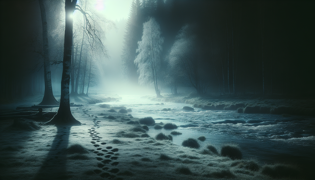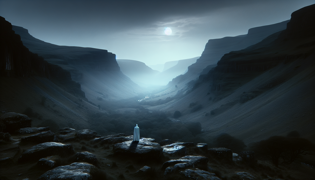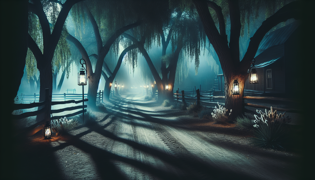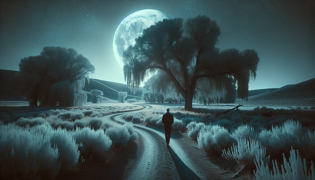Introduction
Moonlight draped the winding path that led into Rio Frio Valley, turning every rock and tree into a pale silhouette. A soft breeze carried the scent of sagebrush and the distant trickle of the river over dry stones. Some nights, when the wind died and the stars flickered low, travelers claimed they heard footsteps behind them, fading into silence as quickly as they appeared. They spoke of a woman clad in a flowing white dress, her face veiled by long dark hair, drifting above the ground. She moved without a sound, her arms outstretched as if reaching for someone long lost. Locals call her La Dama Blanca. Few remember the living woman who came before the legend. She was Maria Santiago, a vibrant young teacher who arrived in the valley in 1908. Her laughter once echoed through adobe classrooms and canyon walls alike. She collected wildflowers, taught girls to read by lantern light, and carried herself with quiet dignity. Under the shade of the ancient cottonwoods, she would read stories of distant lands and faraway seas. But behind her gentle smile lay a spirit that would never know peace. Within a year of her arrival, events took a dark turn. Jealousies and rumors bloomed like poison berries, and one fateful night, Maria vanished without trace. When her body was found days later beneath a granite boulder, the valley fell silent. Grief-stricken witnesses spoke of a pale figure drifting through the moonlit hills in the days that followed. Some claimed they felt a breath at their shoulder, others said they saw her face in the lantern glow. Over the decades, her presence became woven into the valley’s fabric. Ranchers left offerings of fresh water at the riverbank. Children dared one another to call her name at midnight. Visitors reported cold spots and distant sobs echoing through canyon walls. Although the world moved on, the White Lady remained tethered to Rio Frio. Tonight, the breeze still whispers her name. Tonight, the light still trembles beneath her passing. And tonight, anyone brave enough to enter her domain may glimpse the sorrow etched into her ghostly form.
Ghostly Origins
Maria Santiago arrived in Rio Frio Valley in the late summer of 1908, her heart full of hope and curiosity. She had grown up in San Antonio, where her father worked as a merchant in the bustling market district. From an early age she loved books, their pages offering worlds far beyond the limestone walls of her hometown. When the opportunity came to teach at a one-room schoolhouse nestled in the remote valley, she seized it without hesitation. Her presence was like a fresh breeze, filling the dusty adobe rooms with laughter and light. She taught reading, arithmetic, and the English language to children of ranching families, many of whom had never set foot outside the narrow canyon. Each evening, parents and neighbors gathered beneath the cottonwoods for lessons by oil lamp, captivated by the stories she read aloud. The valley seemed to pulse with optimism—until the rumors began. Some said Maria was too friendly with the young ranch hands. Others whispered about her late-night strolls along the river under the moonlight. Jealousy took root, twisting admiration into suspicion. The local sheriff shrugged when questions were raised, dismissing them as idle gossip. But in the hush between sunrise and sunset, resentment simmered. One October night, a single lantern bobbed along the riverbank as Maria collected wild rosemary for her classroom. The scent of the herb mingled with sage and dry earth. Suddenly, the lantern tumbled, shattering glass and spilling oil. A figure emerged from the shadows and without a word raised a fist. The river’s current carried Maria’s soft screams away from the banks. When dawn broke, the valley found her crushed beneath a granite boulder, her dress soaked in mud and blood. There was no trial, only hushed conversations and a promise that justice would be served. Yet justice never came. The man responsible slipped away, leaving Maria’s spirit bound to the place of her final moments. From the moment her lifeless body was discovered, the valley became haunted ground. Travelers spoke of footsteps echoing on empty trails. Ranchers discovered footprints in the dew that vanished at the water’s edge. At the old schoolhouse, lanterns swung even when the wind was still. Some mornings, desks were neatly arranged, as if a ghostly teacher had prepared for class. It was enough to send the bravest hearts homeward. Over time, locals learned to keep a respectful distance. They stacked smooth stones at the riverbank in her honor and left small bouquets of wild rosemary and morning glories. They greeted her name with a bow, acknowledging her continued presence. Yet the truth remained: Maria refused to leave Rio Frio Valley. Mourning and unanswered questions anchored her spirit to the night, ensuring she would wander the trails long after the living had moved on.

The Mourning Valley
As decades passed, the legend of the White Lady grew until it became woven into the valley’s very identity. Ranchero families passed down tales beside hearth fires, warning children to refrain from whistling at midnight. Tourists searching for thrills ventured onto the dusty roads, hoping to glimpse her pale form. Some returned breathless with accounts of a woman in white, her dress illuminated by moonlight, standing in silent vigil beside the river. Others never came back at all. In 1932, a group of geologists mapping the mineral veins along Twin Peaks vanished overnight. Their abandoned camp sprawled in disarray, lanterns still burning low. Tracks led toward the canyon rim and ended abruptly at a cliff’s edge. Locals speculated the White Lady had claimed them as companions, bringing them into the valley’s hidden passages beyond human reach. Reports of her laughter drifting across the river reached the ears of train conductors on the line from San Antonio. One engineer swore he saw a woman in white gliding beside the cars as the train hurtled forward at dawn. He slammed on the brakes and stared in disbelief as she raised her arm, beckoning him closer. The train lurched to a stop, but no living soul stood on the embankment. Only a single white glove lay in the gravel. Superstitious travelers refused to board the next carriage. Churches offered mass in open fields to placate restless spirits. In the 1950s, an ambitious filmmaker arrived determined to capture the White Lady on celluloid. He spent nights camping along the riverbank, stringing lanterns and setting up equipment. On the third night, he recorded a faint humming beneath the wind’s whistle. Reviewing the footage, he found a pale shape drifting through the frame, her face obscured by flowing hair. The film reel ended abruptly, mangled beyond repair. He returned with nothing but grainy stills showing a ghostly shape. By the late 20th century, the valley had embraced its most famous resident. Gift shops sold postcards emblazoned with a silhouette of a woman in white. Tour operators offered guided night hikes promising the highest chance of a sighting. Still, those who ventured out often spoke of an overwhelming sorrow, as if the valley itself wept for a life cut short. Visitors reported chills so fierce they found their breath turning to mist, and an unshakable sense of being watched. On clear nights, when the moon dipped low and the wind slumbered, echoing sobs slipped through canyon walls. The mourning valley earned its name, a place where beauty and tragedy collided beneath the stars. Yet despite the commercialization, the core mystery remained untouched: who was this White Lady, and why did she linger? Local elders insisted that unless her story was told and her death avenged, Maria would never find rest. With every passing generation, her sorrow grew stronger, weaving a net of longing across the valley floor.

Echoes at Dusk
Today, those who brave Rio Frio Valley’s dusk after dark often speak of auditory hauntings as vivid as any specter. On the winding backroads, drivers hear a knock on the passenger window, only to catch their reflection in broken glass and find no one there. Dawn brings no comfort: at sunrise, ranch hands recount the faint echo of schoolchildren reciting lessons in abandoned classrooms. The wind carries soft footsteps, slow and deliberate, circling dusted desks left empty for over a century. Paranormal investigators have journeyed to Rio Frio equipped with the latest technology—electromagnetic field meters, infrared cameras, digital voice recorders. Many have fled by midnight, citing disembodied voices calling out names in Spanish, shadowy figures darting just beyond night vision range. In 2004, a team led by Dr. Elena Marquez placed motion-activated night-vision cameras near the river crossing. Their footage revealed a pale apparition gliding above the water, her dress trailing behind her like mist. As they zoomed in, she raised a hand and pointed upstream. The researchers hesitated, then followed the direction she indicated. Deeper in the valley, they discovered an unmarked grave beneath a lone cottonwood, its wooden marker long since rotted away. The camera recorded a soft sigh, as if relief had washed over the valley. People who visit today still experience similar phenomena. At the old schoolhouse, Mary Russo, a history professor, was cataloging century-old textbooks when she heard the faint turning of pages behind her. She spun around, but no one stood in the dim light of her lantern. Book covers lay open on the floor, their spines creaking as if pressed by a ghostly hand. In February 2019, a wedding party opted for an elopement amid the valley’s rugged beauty. As they exchanged vows under the cottonwoods, a single white rose drifted through the branches and settled at the bride’s feet. She looked up and saw a figure in white standing a few paces away. The wedding guests froze, moved by a sense of calm sorrow that washed over them like the river’s cool current. No harm followed. Instead, the White Lady stepped back into shadow and vanished. That night, the bride dreamed of a woman smiling with eyes full of gratitude before dissolving into a swirl of petals. Some theorize Maria’s spirit has evolved from a restless avenger into a guardian, guiding lost souls and mourning with those who remember her story. Whether she seeks vengeance or comfort may never be clear. Yet the valley remains a place of trembling wonder, where legend and landscape converge beneath a moonlit sky. Each visitor leaves with a fragment of her echo—an unexplainable chill, a whispered name, the imprint of a sorrow that transcends time. For Maria, the boundary between past and present has dissolved, leaving behind only the timeless cry of a spirit bound to a place she loved and lost.

Conclusion
As dawn breaks across the high ridges of Rio Frio Valley, the White Lady’s presence recedes like mist in the early light. Yet the valley’s sorrow remains etched into every stone, every rustle of cottonwood leaves. Maria Santiago’s story has become inseparable from the land she loved—a land now steeped in memory and longing. Visitors continue to seek her out under moonlit skies, following whispers on the wind and footprints in the dew. Some find only silence. Others feel a gentle hand at their shoulder or glimpse a pale silhouette in the gloom, reminding them that loss can linger beyond a single lifetime. Over the years, offerings of rosemary, wildflowers, and small river stones have piled along the banks where Maria’s lantern once swung. People come not merely to chase a ghost but to honor a soul denied justice and to carry forward her tale. The White Lady of Rio Frio remains a beacon of cultural memory for the valley—a reminder that cruelty can bind a spirit, but compassion and remembrance may yet set it free. Legends evolve, but grief endures, weaving through generations like a river’s current that never ceases. In the hush before twilight, listen closely: you might catch the slightest susurration of Maria’s voice rising on the breeze. And if you pause with respect, you may sense her story whisper back to you, an echo of loss and a testament to love’s unending reach across the veil between this world and the next. Tonight, as every night since she first walked these hills, the White Lady of Rio Frio watches and waits, draped in sorrow and moonlight, hoping for the day she finally finds rest beyond the valley’s edge.


















